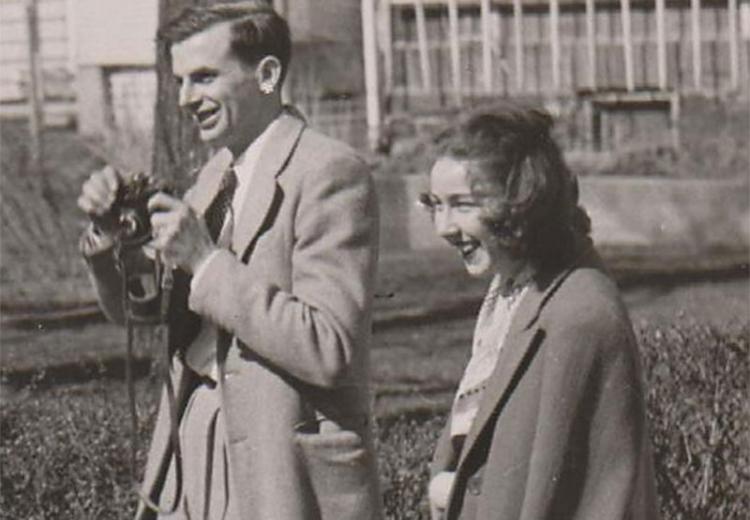Flannery O'Connor's South

Flannery O'Connor (right) at Amana Colonies in Iowa, Oct. 9, 1947.
Flannery O'Connor: Journey through the South, Old and New
Companion activity to Flannery O’Connor's “A Good Man is Hard to Find”: Who's the Real Misfit?
Section 1
Today's starting point? Atlanta. Destination? Florida. Although the family in "A Good Man is Hard to Find" lives in Atlanta, their journey to Florida takes them along the relatively new highways of the 1950s, including rural country roads.
The following images of Georgia highways and rural roads can give you a better idea of highway and country road travel. Though these images are from the 1930s and 1940s, the highways and rural roads would have been similar to those described in "A Good Man is Hard to Find." At the EDSITEment-reviewed American Memory website's Farm Security Administration-Office of War Information Collection, examine the following images (found by searching keywords: "Georgia highways"):
- Highway Sign, Georgia (1939)
- A Greyhound bus trip from Louisville, Kentucky, to Memphis, Tennessee, and the terminals. Georgia highway seen from bus enroute from Chattanooga to Rome, Georgia. (1943)
- Highway near Greensboro, Georgia. (1939)
- Joe Crow and Jim Bishop, truck drivers, stopped to talk along U.S. Highway 29 in Georgia. (1943)
Now view the following images (found by searching "rural roads Georgia"):
- Rural landscape. Georgia, Greene County. (1939)
- A Georgia road and creek. (1939)
- A slick Georgia country road during pause in heavy rain. Near Flint River Farms, Georgia. 1939
Next turn to the EDSITEment-reviewed Smithsonian Institution's National Museum of American History's virtual exhibition America on the Move. Explore in particular the following sections of the exhibition:
- Although the 1950s highways are not what they are today, how are they different from the 1930s/1940s rural roads in Georgia?
- What other technological, economic, and social changes did the U.S. highway system enable in the 1950s?
Section 2
You are looking out the window of the sedan when the grandmother points out "the cute little pickaninny!" This is an offensive, slang term to describe an African-American child. The grandmother also users other terms that are considered quite offensive to us, even though they were quite common for her generation. Consider the following questions, keeping in mind the historical context of O'Connor's story, before examining some of the websites listed below:
- What does the grandmother's use of these words suggest about the racial views she holds?
- What does the grandmother mean when she says, "In my time" at the beginning of this passage?
- How does the grandmother represent the South's earlier times by using this word?
- How does O'Connor use the grandmother to distinguish between the "Old" and "New South"?
- What is symbolic about the fact that the "phantom" plantation is just a figment of the grandmother's bad memory?
While the grandmother's racial views seem outdated and racist to us now, O'Connor's story reflects the complex and difficult relationships of the 1950s South. Change was afoot not only in terms of race, but also in terms of gender, as roles for and stereotypes of women are evolving at this time as well.
Go to the EDSITEment-reviewed American Memory Project and examine the following images:
Section 3
In her essay "The Catholic Novelist in the Protestant South," Flannery O'Connor writes: "I think it is safe to say that while the South is hardly Christ-centered, it is most certainly Christ-haunted." Let's continue our journey through the "Christ-haunted" South. The plot of "A Good Man is Hard to Find" ultimately is about being saved, literally and figuratively, along a rural Southern road. Let's explore images of "Christ-haunted" Georgia from the era between the Depression and WWII. Visit the EDSITEment-reviewed Library of Congress American Memory's "America from the Great Depression to WWII" Collection and browse these images:
- Religious sign on the highway outside of Greensboro, Georgia. (1941)
- Religious sign on highway between Columbus and Augusta, Georgia indicating a revival of interest in religion.
- Religious sign in front of house on highway between Columbus and Augusta, Georgia. Similar religious signs were placed along this highway at intervals of at least a mile and often much closer together. (1940)
- Religious sign on the highway outside of Greensboro, Georgia. (1941)
- Religious signs along highway. Georgia. (1939)
- Religious signs along highway. Georgia. (1939)
- Religious sign on highway between Columbus and Augusta, Georgia, indicating revival of interest in religion. (1940)
- Bailey's family literally sets out on a journey, the family vacation. How does the road trip function as a metaphor or symbol of this journey?
- What might the road trip (and the specific images of the country road) symbolize based on what you have learned from the story at large
